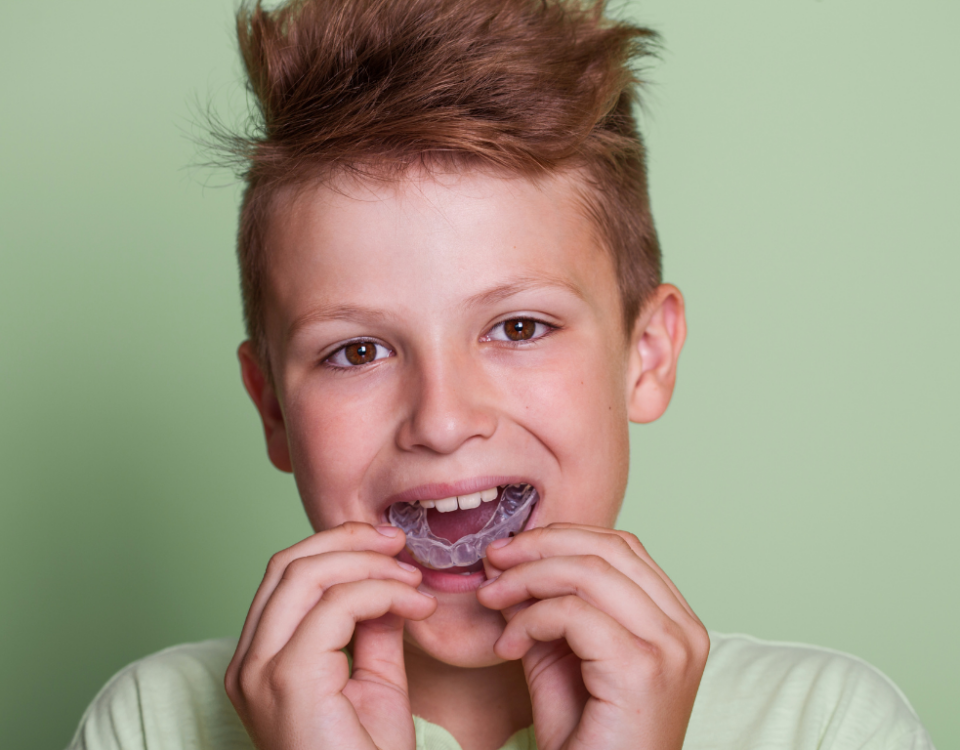
Understanding Out-of-Network Insurance Coverage: What You Need to Know
March 20, 2024
Best Mouthguard For Grinding Teeth
April 30, 2024Key Takeaways:
Importance of Mouthguard Hygiene:
Proper cleaning of your mouthguard is crucial to maintaining oral hygiene and preventing the buildup of bacteria in the mouth.
Types of Mouthguards:
There are five most common kinds of mouthguards – custom-fitted, boil and bite, night guards, stock, and double layer. Each offers different levels of customization, comfort, and protection.
Cleaning Techniques:
Proper maintenance of your mouthguard while prolonging its lifespan requires rinsing with water, brushing with a non-abrasive toothpaste, soaking in a cleaning solution, and regular disinfection.
If you use a mouthguard, whether for sports or teeth grinding, you know how crucial it is to keep it clean. But have you thought about the different types of mouthguards out there or what they’re made of?
In this article, we’re going to discuss mouthguards and get into their different types, how to clean a mouthguard for grinding teeth or other uses, what materials are mouthguards made of, and why it’s key to keep them clean. Whether you’re using one for sports or to deal with teeth grinding, understanding mouthguards can step up your oral care game.
First and Foremost – What Is a Mouthguard Exactly
A mouthguard, also known as a mouth protector or gum shield, is a product that protects the teeth and gums from injury during sports or to treat conditions such as bruxism. It is often composed of long-lasting materials such as thermoplastic polymers or silicone and is intended to absorb and disperse impact forces.
Mouthguards have a dual purpose in dental care. For starters, they provide critical protection during sports by absorbing the impact of hard hits and lowering the danger of fractures, dislocations, or other traumas to the oral structures. Second, they help to prevent dental injuries caused by teeth grinding by providing cushioning that absorbs shock and reduces damage.
In addition to sports and teeth grinding, mouthguards can also be used for various purposes, such as protecting dental work like braces or managing sleep apnea by repositioning the jaw during sleep.
What Are the Different Types of Mouthguards
There are several types of mouthguards available, each offering varying levels of protection, comfort, and customization. Here are the main types:
Stock Mouthguards
These are pre-made mouthguards that come in standard sizes and shapes. They are ready to use right out of the package and are often available at sports stores or pharmacies. While they are affordable and convenient, stock mouthguards may not provide the best fit or comfort since they are not customized to your mouth.
Boil-and-Bite Mouthguards
Boil-and-bite mouthguards are partly customized. They are composed of thermoplastic, which softens when cooked. After boiling, bite into the softened mouthguard to make an impression on your teeth, resulting in a better fit than stock mouthguards. They are also widely accessible in sports stores, providing a balance of price and customization.
Custom-Fitted Mouthguards
Custom-fitted mouthguards are professionally created by dentists using impressions of your teeth. They provide the best fit, protection, and comfort. Custom mouthguards are often composed of durable materials and customized to your exact dental structure, making them excellent for athletes and people with bruxism or similar dental issues.
Double-Layer Mouthguards
Double-layer mouthguards have an inner layer that fits your teeth and an exterior layer for further shock absorption. They provide superior impact protection and are commonly advised for high-contact sports such as football, hockey, and boxing.
Night Guards
Also known as occlusal splints, are specialized mouthguards designed specifically for individuals with teeth grinding or clenching. They are worn during sleep to protect the teeth from wear and reduce jaw muscle tension. Night guards are typically custom-fitted to ensure optimal comfort and effectiveness.
If you are ready to find the perfect mouthguard adjusted to your dental needs, our team at Dental Langley Care is here to help. With our expertise and personalized approach, we’ll guide you in selecting the ideal mouthguard based on factors like protection level, comfort, durability, and budget.
What Materials Are Mouthguards Made From
Mouthguards are commonly made from materials such as Polyvinyl Chloride (PVC), Polyurethane (PU), and Ethylene Vinyl Acetate (EVA), each offering unique properties of durability, flexibility, and comfort for dental protection. Let’s analyze each material:
Polyvinyl Chloride (PVC)
PVC, short for Polyvinyl Chloride, stands out as a popular choice for mouthguards because of its excellent combination of durability and flexibility. This material offers long-lasting protection and comfort, making it ideal for dental applications.
What makes PVC mouthguards so effective is their ability to strike a balance between strength and comfort. They are strong enough to endure the demands of physical activities while remaining flexible enough to provide a comfortable fit for users.
Keep in mind that PVC’s durability ensures that the mouthguard maintains its shape and effectiveness even after repeated use. This longevity factor enhances the overall value and reliability of PVC mouthguards, making them a trusted option for dental protection.
Polyurethane (PU)
Polyurethane (PU) is a popular choice in the manufacture of mouthguards due to its superior comfort and protective characteristics. PU materials excel at cushioning and impact resistance, ensuring a secure fit and increased protection for tooth health.
Mouthguards with PU provide a pleasant and flexible sensation, relieving stress on the jaw during hits. This material quickly adapts to the shapes of the teeth, resulting in a custom fit that maximizes comfort. PU’s outstanding resilience assures long-lasting performance, making it a perfect choice for athletes and those looking for trustworthy tooth protection.
Also, PU’s lightweight nature improves the overall user experience by reducing bulk and allowing for easier speaking and breathing while wearing the mouthguard. It’s no surprise that PU has become the favored material for mouthguard manufacturing, providing a perfect balance of comfort, protection, and durability.
Ethylene Vinyl Acetate (EVA)
Ethylene Vinyl Acetate (EVA), known for its flexibility and comfort, is a popular material in mouthguard production. EVA’s soft and malleable feel ensures a pleasant and snug fit while also providing superior oral protection.
The flexibility of EVA allows mouthguards to easily mold to the user’s teeth and jawline, resulting in a tailored fit that improves comfort and reduces injury risks during sports or teeth grinding. In addition, EVA’s qualities allow it to absorb impact and equally distribute pressure, reducing the risk of tooth or jaw injuries in the case of a sudden impact or accident.
How To Clean Mouthguard for Grinding Teeth
Cleaning your mouthguard involves a combination of rinsing with water, brushing with toothpaste, soaking in a cleaning solution, and periodically disinfecting to ensure proper maintenance and hygiene.
Rinse with Water
Rinsing your mouthguard with water after each use to help prevent bacteria and debris. It is a simple yet essential step in the regular maintenance of your mouthguard.
By rinsing the mouthguard with water, any remnants of food particles or bacteria that may have accumulated during use are washed away.
This practice not only safeguards your oral hygiene but also prolongs the lifespan of your mouthguard by reducing the risk of bacterial buildup.
Brush with toothpaste
Brushing your mouthguard with toothpaste using a soft-bristled brush helps clean off residue and maintain daily freshness. This practice ensures thorough cleaning and prevents odor or mold buildup.
Make sure to gently scrub the entire surface of the mouthguard, including the crevices and grooves where bacteria can hide.
Remember to rinse the mouthguard thoroughly after brushing to remove any leftover toothpaste residue.
Soak in Mouthguard Cleaner
Soaking your mouthguard in a specialized cleaner helps disinfect and sanitize eliminating any bacteria or germs. Regular soaking is crucial to prevent infections.
If you prefer a DIY approach, combining equal parts of white vinegar and hydrogen peroxide in a bowl can effectively eliminate bacteria.
Simply immerse the mouthguard in this solution for about 15-30 minutes before rinsing it thoroughly with water. This simple yet powerful method can aid in preventing the buildup of harmful germs.
Use Mouthguard Disinfectant Spray
Using a mouthguard disinfectant spray helps kill bacteria, germs, and odor-causing agents, ensuring your guard remains fresh and ready to use. Regular application of the spray aids in preventing bacterial growth and maintaining oral health.
The convenience of disinfectant sprays makes it easy to ensure your mouthguard stays clean, whether after each use or regularly. Look for sprays specifically formulated for mouthguards to ensure effective sanitization.
Every Now And Then, Perform a Deep Cleaning Process
Periodically, perform a deep cleaning of your mouthguard to remove stubborn buildup and bacteria. You can soak the mouthguard in a mixture of water and vinegar for about 30 minutes, followed by thorough rinsing and air drying.
Follow these simple yet efficient cleaning techniques to keep your mouthguard clean, hygienic, and ready to provide.
How Often Should You Clean Your Mouthguard
It is recommended to clean your mouthguard daily to prevent bacteria buildup and maintain optimal hygiene. Establishing a regular maintenance routine ensures that your mouthguard remains fresh and free from germs.
Regular cleaning and disinfection of your mouthguard not only keeps it hygienic but also ensures its longevity. By incorporating simple practices like rinsing your mouthguard with warm water after each use and letting it air dry thoroughly, you can prevent bacterial accumulation effectively.
Why Is it Important to Clean Your Mouthguard
Failure to clean your mouthguard regularly creates a perfect environment for germs to thrive, increasing the risk of infections and oral health issues.
Also, accumulated bacteria and debris can cause your mouthguard to develop unpleasant odors over time. Regular cleaning helps keep it fresh and odor-free, ensuring a more pleasant experience during use.
Also, did you know that proper cleaning and maintenance can extend the lifespan of your mouthguard? Regularly cleaning and storing it properly helps prevent premature wear and tear, ensuring that it remains in good condition for longer use.
Tips for Maintaining and Storing Your Mouthguard
Don’t Use Hot Water
Avoid using hot water to clean or soak your mouthguard as it can potentially damage the material and compromise its effectiveness. Opt for lukewarm or cool water to maintain hygiene and prevent any distortions in the guard.
The high temperature can soften the material, leading to warping or cracking. This not only reduces the guard’s ability to provide proper cushioning and protection but also creates spaces where bacteria can accumulate, increasing the risk of infections and oral health issues.
Avoid Using Harsh Chemicals
Avoid harsh chemicals such as bleach or alcohol-based solutions when cleaning your mouthguard, as they can degrade the material and cause damage. Opt for gentle cleaners or specialized solutions.
Using gentle cleaners like mild soap and water or mouthguard cleaning tablets can effectively remove bacteria and odors without compromising the structure of the guard.
Store in a Protective Case
Storing your mouthguard in a protective case when not in use shields it from external damage, bacteria, and dust, maintaining its cleanliness and hygiene. A proper storage case helps retain the guard’s shape and prolong its lifespan.
Plus safeguarding your mouthguard from impacts and microbial contamination, a protective case also plays a crucial role in preserving the guard’s structural integrity. By preventing dust and debris from accumulating on the guard’s surface.
Investing in a suitable storage solution not only promotes better oral hygiene but also contributes to the overall longevity of your mouthguard, ultimately ensuring reliable and durable dental protection.
Replace When Necessary
Monitor your mouthguard for signs of wear, tear, or deterioration, and replace it when necessary.
Some common signs that indicate your mouthguard may need to be replaced include cracks, tears, or deformities in the material. If you notice any of these issues, it’s crucial to get a new mouthguard promptly to avoid compromising its protective capabilities.
By staying vigilant and proactive in monitoring the condition of your mouthguard, you can safeguard your teeth, jaws, and overall oral health.
Book Your Custom Mouthguard Appointment Today
Don’t compromise on your dental protection. Schedule an appointment with Langley Dental Care to create a personalized mouthguard that fits you perfectly. Our team of experts will ensure you get comfort and security whether you need a mouthguard for sports, teeth grinding, or overall oral health.
Our dentists will not only craft the perfect fit but also provide detailed guidance on how to clean your mouthguard, whether it’s for grinding teeth or other uses. Take the first step towards a confident and protected smile—book your appointment with us today.
Frequently Asked Questions
How do I clean my mouthguard for grinding teeth?
To clean your mouthguard for grinding teeth, begin by rinsing it with cool water to remove any debris or saliva. Then, use a soft-bristled toothbrush and non-abrasive toothpaste to gently scrub the inside and outside of the guard. Rinse it thoroughly and leave it to air dry before storing it in a clean case.
Can I use regular toothpaste to clean my mouthguard for grinding teeth?
No, regular toothpaste can be too abrasive and damage the material of the mouthguard. It is best to use a non-abrasive toothpaste specifically designed for cleaning mouthguards, or a mild soap and water solution.
How often should I clean my mouthguard for grinding teeth?
It is recommended to clean your mouthguard after each use to prevent bacteria buildup. If you are unable to clean it immediately, at least rinse it with cool water and clean it thoroughly before using it again.
Can I use hot water to clean my mouthguard for grinding teeth?
No, hot water can warp the shape of your mouthguard and render it ineffective. Always use cool or lukewarm water to clean your mouthguard.
Do I need to use a mouthguard cleaner to clean my mouthguard for grinding teeth?
No, a simple scrub with a toothbrush and non-abrasive toothpaste or mild soap and water solution is sufficient for cleaning your mouthguard. However, using a mouthguard cleaner can help remove stubborn stains and odors.
How do I store my mouthguard for grinding teeth?
After cleaning your mouthguard, make sure it is completely dry before storing it in a clean case. Avoid storing it in direct sunlight or areas with high heat, as this can damage the material. It is also important to regularly replace your mouthguard to ensure proper fit and hygiene.



